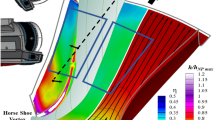Abstract
Methods employed and experience gained in measuring random fluid-boundary-layer pressures on the surface of a small-diameter cylindrical rod subject to dense, nonhomogeneous, turbulent, parallel flow in a relatively noise-contaminated flow loop are described. Emphasis is placed on identification of instrumentation problems; description of transducer construction and mounting; and the pretest calibration required to achieve instrumentation capable of reliable data acquisition.
Similar content being viewed by others
Abbreviations
- a 1 :
-
rod amplitude at fundamental frequencyf 1
- d :
-
rod diameter
- d t :
-
transducer diameter
- D :
-
outside diameter of annular region
- D h :
-
hydraulic diameter
- f 1 :
-
fundamental rod frequency
- k * :
-
wave numberf/V
- P s :
-
stagnation pressure
- T :
-
turbulent eddy-time period
- V :
-
mean flow velocity
- \(\varrho _f \) :
-
fluid-mass density
- \(\Phi _p \) :
-
spectral density
References
Wilmarth, W.W., “Pressure Fluctuations Beneath Turbulent Boundary Layers,”Annual Review of Fluid Mechanics,7,13–38 (1975).
Chen, S.S. andWambsganss, M.W., “Parallet-Flow-Induced Vibration of Fuel Rods,”Nucl. Eng. Design,18,253–278 (1972).
Brighton, J.A. andJones, J.B., “Full Developed Turbulent Flow in Annuli,”J. Basic Eng., Trans. ASME,86,835–844 (1964).
Wambsganss, M.W. and Zaleski, P.L., “Measurement, Interpretation and Characterization of Near Field Flow Noise,” Proceedings of the Conference on Flow Induced Vibrations in Reactor Components, Argonne National Laboratory Report ANL-7685, 112–137 (1970).
Bull, M.K. andThomas, A.S.W., “High Frequency Wall-Pressure Fluctuations in Turbulent Boundary Layers,”The Physics of Fluids,19 (4),597–599 (1976).
Aupperle, F.A. andLambert, R.F., “Effects of Surface Roughness on Measured Wall-Pressure Fluctuations Beneath a Turbulent Boundary Layer,”J. Acoust. Soc. Am.,47 (1),359–370 (1970).
Hanly, R.D., “Effects of Transducer Flushness on Fluctuating Surface Pressure Measurements,”Progress in Astronautics and Aeronautics,46,291–302 (1976).
Paidoussis, M.P., “An Experimental Study of the Vibration of Flexible Cylinders Induced by Nominally Axial Flow,”Nucl. Sci. Eng.,35,127–138 (1969).
Wambsganss, M.W., Jendrzejczyk, J.A. and Lawrence, W.P., “Wall Pressure Fluctuations on a Cylinder in Annula Water Flow,” Argonne National Laboratory Report ANL-CT-79-38 (1979).
Mulcahy, T.M., et al., “Measurements of Wall Pressure Fluctuations on a Cylinder in Annular Water Flow with Upstream Disturbances,” Argonne National Laboratory Report ANL-CT-81-11 (1980).
Author information
Authors and Affiliations
Rights and permissions
About this article
Cite this article
Mulcahy, T.M., Lawrence, W. & Wambsganss, M.W. Dynamic surface-pressure instrumentation for rods in parallel flow. Experimental Mechanics 22, 31–36 (1982). https://doi.org/10.1007/BF02325701
Received:
Accepted:
Issue Date:
DOI: https://doi.org/10.1007/BF02325701



